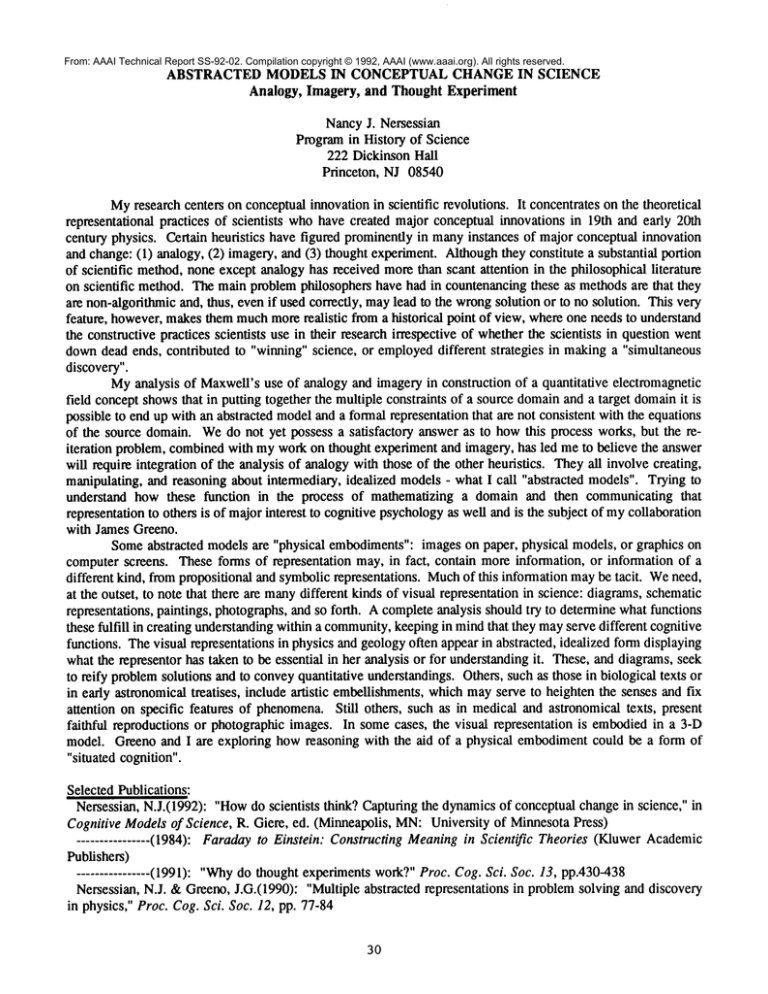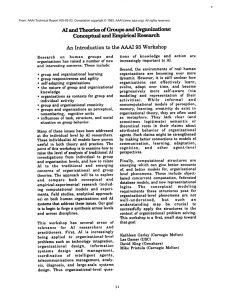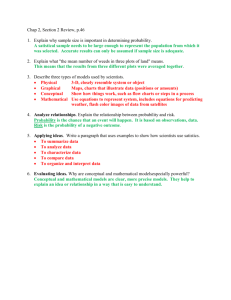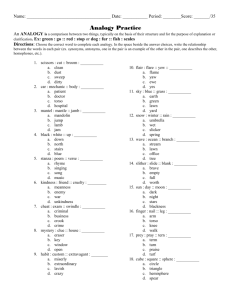
From: AAAI Technical Report SS-92-02. Compilation copyright © 1992, AAAI (www.aaai.org). All rights reserved.
ABSTRACTED MODELS IN CONCEPTUAL CHANGE IN SCIENCE
Analogy, Imagery, and Thought Experiment
NancyJ. Nersessian
Programin History of Science
222 Dickinson Hall
Princeton, NJ 08540
Myresearch centers on conceptual innovation in scientific revolutions. It concentrates on the theoretical
representational practices of scientists whohave created major conceptual innovations in 19th and early 20th
century physics. Certain heuristics have figured prominently in manyinstances of major conceptual innovation
and change: (1) analogy, (2) imagery, and (3) thought experiment. Althoughthey constitute a substantial portion
of scientific method,none except analogy has received morethan scant attention in the philosophical literature
on scientific method. The main problem philosophers have had in countenancing these as methodsare that they
are non-algorithmicand, thus, even if used correctly, maylead to the wrongsolution or to no solution. This very
feature, however, makesthem muchmore realistic from a historical point of view, whereone needs to understand
the constructive practices scientists use in their research irrespective of whetherthe scientists in question went
downdead ends, contributed to "winning" science, or employeddifferent strategies in makinga "simultaneous
discovery".
Myanalysis of MaxweU’s
use of analogy and imagery in construction of a quantitative electromagnetic
field concept showsthat in putting together the multiple constraints of a source domainand a target domainit is
possible to end up with an abstracted modeland a formal representation that are not consistent with the equations
of the source domain. Wedo not yet possess a satisfactory answer as to howthis process works, but the reiteration problem, combinedwith mywork on thought experiment and imagery, has led me to believe the answer
will require integration of the analysis of analogy with those of the other heuristics. Theyall involve creating,
manipulating, and reasoning about intermediary, idealized models - what I call "abstracted models". Trying to
understand how these function in the process of mathematizing a domain and then communicating that
representation to others is of major interest to cognitive psychologyas well and is the subject of mycollaboration
with James Greeno.
Someabstracted models are "physical embodiments":images on paper, physical models, or graphics on
computer screens. These forms of representation may, in fact, contain more information, or information of a
different kind, from propositional and symbolic representations. Muchof this information maybe tacit. Weneed,
at the outset, to note that there are manydifferent kinds of visual representation in science: diagrams, schematic
representations, paintings, photographs, and so forth. A completeanalysis should try to determine what functions
these fulfill in creating understandingwithin a community,keeping in mindthat they mayserve different cognitive
functions. Thevisual representations in physics and geologyoften appear in abstracted, idealized form displaying
what the representor has taken to be essential in her analysis or for understanding it. These, and diagrams, seek
to reify problemsolutions and to conveyquantitative understandings. Others, such as those in biological texts or
in early astronomical treatises, include artistic embellishments,whichmayserve to heighten the senses and fix
attention on specific features of phenomena.Still others, such as in medical and astronomical texts, present
faithful reproductions or photographic images. In some cases, the visual representation is embodiedin a 3-D
model. Greeno and I are exploring how reasoning with the aid of a physical embodimentcould be a form of
"situated cognition".
Selected Publications:
Nersessian, N.J.(1992): "Howdo scientists think? Capturing the dynamicsof conceptual change in science,"
Cognitive Models of Science, R. Giere, ed. (Minneapolis, MN:University of Minnesota Press)
................
(1984): Faradayto Einstein: Constructing Meaningin Scientific Theories (Kluwer Academic
Publishers)
................
(1991): "Whydo thought experiments work?"Proc. Cog. Sci. Soc. 13, pp.430-438
Nersessian, N.J. & Greeno, J.G.(1990): "Multiple abstracted representations in problem solving and discovery
in physics," Proc. Cog. Sci. Soc. 12, pp. 77-84
3O





